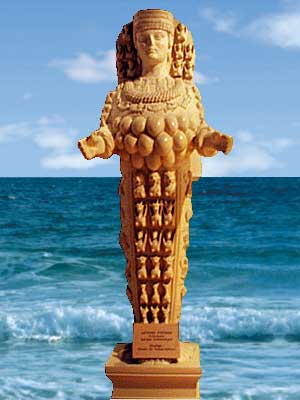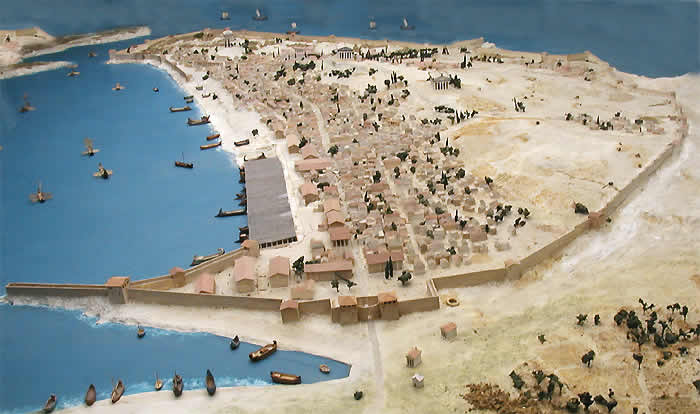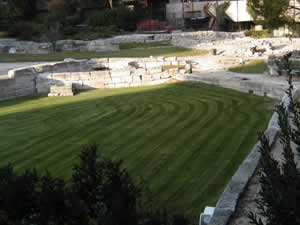Massalia was born from the union of Protis and Gyptis around the year 600 BC. The Massaliotes quickly organized their city which had a few thousand inhabitants at the time of Pytheas. Their laws are considered the wisest in the Greek world. Massalia is also the “regulator of sciences”.
According to tradition, reported by Strabo and Justin, the foundation of Marseille, Massilia at the time of Rome, dates back to the year 600 BC. Sailors from Phocaea (Foça today, on the west coast of Turkey) commanded by Protis, ready to leave for the western Mediterranean, receive an oracle: They must take a guide from the temple of Artemis of Ephesus. It is Aristarchus, "one of the most respected women". They also take a wooden statue of the goddess Artemis.
 |
Copy of a statue of the goddess Artemis of Ephesus. Marseille History Museum. The body is covered with animals, the bust with bull testicles. Artemis is thus the protector of animals and the goddess of fertiçlity (1) |
They landed in the cove of Lacydon, the current old port of Marseille. The banks were occupied by a Ligurian tribe whose leader was Nannos. That day, the Celts organized a festival at the end of which Gyptis, daughter of Nannos, had to choose her husband. As a sign of friendship, they invited the new arrivals. Gyptis chose Protis. King Nannos accepted and gave the Greeks the entire northern part of Lacydon to create a city.
This beautiful romanticized story cannot hide the habits of the Greeks. It is possible that the conquest of the site was not done by marriage, but rather by force.
The Greeks built their first temple and Aristarchus became its priestess. According to Strabo, the temple of Artemis is located just above the port, right next to that of Apollo. Perhaps on the Butte St Laurent or that of the Moulins.
The date of 600 BC corresponds well with the archaeological excavations. The amphorae discovered on the site are from this period.
Other historians put forward the date of 545 BC. The Phocaeans fleeing their city besieged by the Persians commanded by Cyrus, decided to settle in the western Mediterranean. They first created Alalia (Aléria in Corsica), just opposite the Etruscans who took offense, and entered into conflict. Then it was Vélia and finally Massalia.
Recent archaeological discoveries (ceramics and old quay of the Place Vileneuve Bargemon) show that it was at the beginning of the 6 BC that Massalia was created. It is possible that, a few decades later, the fugitives were welcomed by Massilia (Massalia then Marseille). Marseille is thus the oldest city in France.
The city developed rapidly. At the time of Pytheas, 250 years later, it had a few thousand inhabitants
.
 |
Model of Massilia at the time of the Greeks. Marseille History Museum |
The Greeks very quickly sought to organize their city by providing it with a remarkable constitution, while respecting their beliefs. The Massaliotes elected the equivalent of deputies: they were the Timouques, 600 in number, elected for life. They were the guardians of honor. To be able to be a candidate, the family must have children and it must have been Massaliote for at least 3 generations.
The Timouques elected 15 wise men to govern quickly, as well as a triumvirate who had final power. Strabo indicates that the laws are based on those in force in Greece and that they are posted to be seen by all. Aristotle, a contemporary of Pytheas, said: "Of all the Greek cities, the most wisely balanced".
The city occupies the northern edge of Lacydon. This cove is extremely well chosen. It is wide towards the interior, but it is not bordered by cliffs like the others towards the East. The entrance is narrow (about 100 m), so the site is easily defended against any incursion from the sea. The prevailing winds only raise a few ripples on the water
.
 |
The horn of the port of Massilia in Roman times |
At the time of Pytheas, Massilia extended to the Butte des Carmes, and, towards the north, to the Anse de l’Ourse (Joliette). A wall encloses the city, except towards the port. The main entrance gate is at the very end of the horn of the old port. The main street follows more or less the route of the current Grand Rue and Rue Caisserie. .
(1) The bust is covered with a kind of egg. Some think they are women's breasts. Later bull testicles and finally palm dates.

